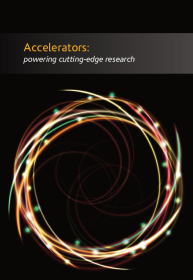|
 Accelerators: Powering Cutting Edge Research Accelerators: Powering Cutting Edge Research
by Charlotte Houghton (STFC)
 
Fig 1 left: Image on the inside cover. 3D model of Diamond Light Source. Image credit: Diamond Light Source
Fig 2 right: Accelerators brochure front cover. Image credit: STFC
What are the practical benefits of particle accelerators? Look out for a brand new brochure, due out this September, which will help accelerator scientists explain the benefits of their work to the general public. By using real-life examples and scenarios everybody can relate to, Accelerators: Powering Cutting Edge Research explores the many areas in which accelerator science has made a positive impact on modern life.
The brochure has been produced by the Science and Technology Facilities Council, the Cockcroft Institute and the Institute of Physics. It has been commissioned to raise public awareness of the benefits of particle accelerators in research, through case studies that answer questions such as:
- How can we meet our energy needs without adding to greenhouse gas emissions?
- How will border protection agencies, and the technology they use, continually evolve to face the ever growing threat of terrorist attacks?
- How can we find new ways of preserving our cultural heritage?
Featuring particle accelerators from around the world, the brochure highlights how accelerators influence our everyday lives by covering topics such as:
- Energy- solar cells, keeping the lights on at power stations and turning carbon monoxide into fuel.
- Radiotherapy- treating cancer patients, improving diagnosis and radiotherapy efficiency, and developing new cancer treatments.
- Medicine- treating HIV, detecting Parkinson’s disease and dealing with diabetes.
- The environment- storing hydrogen, studying clouds and decontaminating Fukushima.
- Industry- fuelling the economy, making life sweeter and making aircraft safer.
- Security- detecting terrorist threats, solving mysterious deaths and fighting counterfeiters.
- And finally, the natural world and heritage science- conserving our heritage, calculating landslide risks and analysing Roman remains.
Read more >>

|